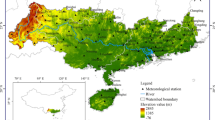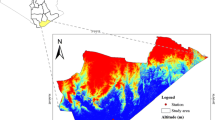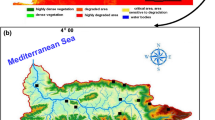Abstract
A revisited hydrological drought analysis is necessary for a human-modified period where human activities in addition to natural processes can influence runoff. Hence, a new drought indexing approach (NDIA) is proposed for indexing hydrological drought in response to climatic and anthropogenic contributions. The NDIA involves three main components, namely, trend and change-point analysis, the estimation of runoff variability induced by climate and human activities, and indexing steps. The current study showed that during the study period (1983–2012), with a change point in approximately 1997–1998, 3.16% and 0.93% decreases in the annual average runoff and precipitation, respectively, with an insignificant increase in potential evapotranspiration, were observed from period 1 (1983–1997) to period 2 (1998–2012). The hydrological analysis showed that climatic and land use changes contributed 69.4% and 30.6%, respectively, to mean runoff variability, which indicated the need to consider human contributions in drought analysis during the disturbed period (1998–2012). Hence, using the proposed hydrological drought indexing process in the disturbed period, human-induced drought (HID) and climate-induced drought (CID) were individually estimated. The analysis showed that the duration of HID was less than that of CID, but the number of events was high. The findings were also cross-compared with basin development information and land use classification using a geographic information system (GIS), and this cross-comparison confirmed human intervention during the disturbed period. Based on the overall results, it was concluded that anthropogenic intrusions altered the hydrological time series and instigated or alleviated drought events in the Anthropocene.









Similar content being viewed by others
References
Adnan S, Mahmood R, Khan AH (2009) Water balance conditions in rainfed areas of Potohar and Balochistan plateau during 1931-08. World Appl Sci J 7:162–169
Adnan S, Ullah K, Gao S (2015) Characterization of drought and its assessment over Sindh, Pakistan during 1951–2010. J Meteorol Res 29:837–857
Ahmad S, Hussain Z, Qureshi AS, Majeed R, Saleem M (2004) Drought mitigation in Pakistan: current status and options for future strategies.Work. Pap. 85, Int Water Manage Inst Colombo, Sri Lanka.
Ahmed K, Shahid S, Nawaz N (2018) Impacts of climate variability and change on seasonal drought characteristics of Pakistan. Atmos Res 214:364–374
Anjum S, Saleem M, Cheema M, Bilal M, Khaliq T (2012) An assessment to vulnerability, extent, characteristics and severity of drought hazard in Pakistan. Pakistan J Sci 64:138
Anjum SA, Wang L, Salhab J, Khan I, Saleem M (2010) An assessment of drought extent and impacts in agriculture sector in Pakistan. J Food Agric Environ 8:1359–1363
Ashfaq A, Ashraf M, Bahzad A (2014) Spatial and temporal assessment of groundwater behaviour in the Soan basin of Pakistan. Univ Eng Technol Taxila Technical J 19:12
Bao Z et al (2012) Attribution for decreasing streamflow of the Haihe River basin, northern China: climate variability or human activities? J Hydrol 460:117–129
Cong Z, Shahid M, Zhang D, Lei H, Yang D (2017) Attribution of runoff change in the alpine basin: a case study of the Heihe Upstream Basin, China. Hydrol Sci J 62:1013–1028
Gill MA, Mushtaq K (1998) Case study on Agriculture Department of Punjab Province. Int Water Manage Inst. https://books.google.com.pk/books?id=pv6K7lXjC4QC
Gumus V, Algin HM (2017) Meteorological and hydrological drought analysis of the Seyhan−Ceyhan River basins, Turkey. Meteorol Appl 24:62–73. https://doi.org/10.1002/met.1605
Jiang R, Xie J, He H, Luo J, Zhu J (2015) Use of four drought indices for evaluating drought characteristics under climate change in Shaanxi China: 1951–2012. Nat Hazards 75(3): 2885–2903. https://doi.org/10.1007/s11069-014-1468-x
Kingston DG, Stagge JH, Tallaksen LM, Hannah DM (2014) European-scale drought: understanding connections between atmospheric circulation and meteorological drought indices. J Clim 28:505–516. https://doi.org/10.1175/JCLI-D-14-00001.1
Khan MYA, Hasan F, Panwar S, Chakrapani GJ (2016) Neural network model for discharge and water-level prediction for Ramganga River catchment of Ganga Basin, India. Hydrol Sci J 61:2084–2095. https://doi.org/10.1080/02626667.2015.1083650
Khan MYA, Hasan F, Tian F (2019a) Estimation of suspended sediment load using three neural network algorithms in Ramganga River catchment of Ganga Basin, India. Sustain Water Resourc Manag 5:1115–1131. https://doi.org/10.1007/s40899-018-0288-7
Khan MYA, Tian F, Hasan F, Chakrapani GJ (2019b) Artificial neural network simulation for prediction of suspended sediment concentration in the River Ramganga, Ganges Basin, India. Int J Sediment Res 34:95–107. https://doi.org/10.1016/j.ijsrc.2018.09.001
Lea C, Curtis A (2010) Thematic accuracy assessment procedures: National Park Service vegetation inventory, version 2.0 Natural resource report NPS/2010/NRR-2010/204 Fort Collins: National Park Service, US Department of the Interior
Li S, Xiong L, Li H-Y, Leung LR, Demissie Y (2016) Attributing runoff changes to climate variability and human activities: uncertainty analysis using four monthly water balance models. Stoch Env Res Risk A 30:251–269. https://doi.org/10.1007/s00477-015-1083-8
Majeed S, Ali I, Zaman SB, Ahmad S (2010) Productivity of mini dams in Pothwar Plateau: a diagnostic analysis. Research Briefings, Natural Research Division, PARC, Islamabad 2:208–214
Mann HB (1945) Nonparametric tests against trend. Econometrica 13:245–259. https://doi.org/10.2307/1907187
Martinez GF, Gupta HV (2010) Toward improved identification of hydrological models: a diagnostic evaluation of the “abcd” monthly water balance model for the conterminous United States. Water Resour Res 46:n/a-n/a. https://doi.org/10.1029/2009WR008294
Mishra AK, Singh VP (2010) A review of drought concepts. J Hydrol 391:202–216
Nalbantis I, Tsakiris G (2009) Assessment of hydrological drought revisited. Water Resour Manag 23:881–897. https://doi.org/10.1007/s11269-008-9305-1
Nathan LH, Hans Ulrich A (2002) Cover crops and living mulches. Weed Sci 50:688–699
Pakistan I (2005) Rapid environmental appraisal of developments in and around murree hills. Tech. rep., IUCN, Pakistan
Pettitt AN (1980) A simple cumulative sum type statistic for the change-point problem with zero-one observations. Biometrika 67:79–84
Qin Y, Yang D, Lei H, Xu K, Xu X (2015) Comparative analysis of drought based on precipitation and soil moisture indices in Haihe basin of North China during the period of 1960–2010. J Hydrol 526:55–67
Rangecroft S, Van Loon AF, Maureira H, Verbist K, Hannah DM (2016) Multi-method assess ment of reservoir effects on hydrological droughts in an arid region. Earth Syst Dynam Discuss 2016:1–32. https://doi.org/10.5194/esd-2016-57
Schlaepfer DR, Bradford JB, Lauenroth WK, Munson SM, Tietjen B, Hall SA, Wilson SD, Duniway MC, Jia G, Pyke DA, Lkhagva A, Jamiyansharav K (2017) Climate change reduces extent of temperate drylands and intensifies drought in deep soils. Nat Commun 8:14196. https://doi.org/10.1038/ncomms14196
Shahid M, Cong Z, Zhang D (2018) Understanding the impacts of climate change and human activities on streamflow: a case study of the Soan River basin, Pakistan. Theor Appl Climatol 134:205–219. https://doi.org/10.1007/s00704-017-2269-4
Tallaksen L, Lanen HAJ (2004) Hydrological drought. Processes and estimation methods for streamflow and groundwater. Developments in water science, vol 48. Elsevier, Amsterdam
Tigkas D, Vangelis H, Tsakiris G (2014) DrinC: a software for drought analysis based on drought indices. Earth Sci Inf 8: 697–709. https://doi.org/10.1007/s12145-014-0178-y
Van Loon AF et al (2016a) Drought in the Anthropocene. Nat Geosci 9:89–91. https://doi.org/10.1038/ngeo2646
Van Loon AF et al (2016b) Drought in a human-modified world: reframing drought definitions, understanding, and analysis approaches. Hydrol Earth Syst Sci 20:3631–3650. https://doi.org/10.5194/hess-20-3631-2016
Van Loon AF, Van Lanen HAJ (2013) Making the distinction between water scarcity and drought using an observation-modeling framework. Water Resour Res 49:1483–1502. https://doi.org/10.1002/wrcr.20147
Vicente-Serrano SM, Beguería S, López-Moreno JI (2010) A multiscalar drought index sensitive to global warming: the standardized precipitation evapotranspiration index. J Clim 23:1696–1718. https://doi.org/10.1175/2009jcli2909.1
Wanders N, Wada Y (2015) Human and climate impacts on the 21st century hydrological drought. J Hydrol 526:208–220
Wanders N, Wada Y, Van Lanen HAJ (2015) Global hydrological droughts in the 21st century under a changing hydrological regime. Earth Syst Dynam 6:1–15. https://doi.org/10.5194/esd-6-1-2015
Wang W, Shao Q, Yang T, Peng S, Xing W, Sun F, Luo Y (2012) Quantitative assessment of the impact of climate variability and human activities on runoff changes: a case study in four catchments of the Haihe River basin, China. Hydrol Process 27:1158–1174. https://doi.org/10.1002/hyp.9299
Waseem M, Ajmal M, Kim T-W (2015) Development of a new composite drought index for multivariate drought assessment. J Hydrol 527:30–37
Waseem M, Ajmal M, Lee JH, Kim T-W (2016a) Multivariate drought assessment considering the antecedent drought conditions. Water Resour Manag 30:4221–4231
Waseem M, Park D-H, Kim T-W (2016b) Comprehensive climatological drought projection over South Korea under climate change. Procedia Eng 154:284–290
Xu K, Yang D, Yang H, Li Z, Qin Y, Shen Y (2015) Spatio-temporal variation of drought in China during 1961–2012: a climatic perspective. J Hydrol 526:253–264
Zargar A, Sadiq R, Naser B, Khan FI (2011) A review of drought indices. Environ Rev 19:333–349. https://doi.org/10.1139/a11-013
Acknowledgments
The authors acknowledge the Pakistan Meteorology Department (PMD) and the Water and Power Development Authority (WAPDA) Pakistan for providing the data for this research.
Funding
This research was sponsored by the Natural Science Foundation of Hubei Province of China (2019CFB188), the Project (2018A003) of Hubei Key Laboratory of Regional Development and Environmental Response (Hubei University) and HEC project #10777.
Author information
Authors and Affiliations
Corresponding author
Additional information
Publisher’s note
Springer Nature remains neutral with regard to jurisdictional claims in published maps and institutional affiliations.
Rights and permissions
About this article
Cite this article
Muhammad, W., Muhammad, S., Khan, N.M. et al. Hydrological drought indexing approach in response to climate and anthropogenic activities. Theor Appl Climatol 141, 1401–1413 (2020). https://doi.org/10.1007/s00704-020-03227-y
Received:
Accepted:
Published:
Issue Date:
DOI: https://doi.org/10.1007/s00704-020-03227-y




